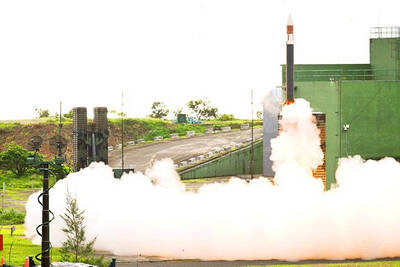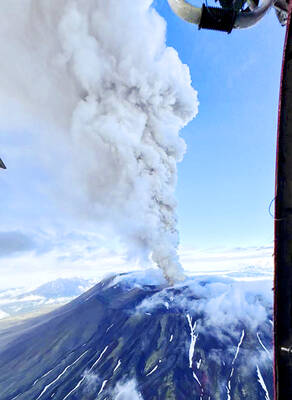China yesterday refused to disclose why Qin Gang (秦剛) had been sacked as foreign minister, insisting it was releasing information “normally,” despite him having not been seen publicly for more than a month.
Qin was removed from office by Beijing’s top lawmaking body on Tuesday after just 207 days in the job, following weeks of speculation that the former ambassador to the US and confidant of Chinese President Xi Jinping (習近平) had fallen out of favor.
Asked at a regular briefing about his removal, Chinese Ministry of Foreign Affairs spokeswoman Mao Ning (毛寧) referred journalists to a state news agency article and declined to offer any further information.

Photo: AFP
“Xinhua has already published information. You can refer to that,” Mao said.
Asked how she evaluated Qin’s brief stint as foreign minister, Mao said that she was “probably not the right person to answer that question.”
“I don’t think it’s appropriate for me to pass judgement,” she said, adding that China was “releasing normal information” concerning Qin’s position.
Pressed repeatedly by journalists to provide more details about Qin’s fate, Mao said that decisions made on Tuesday by China’s top lawmaking body and the president were “very clear.”
“I suggest you all refer to that. I don’t have any additional information,” she said.
“China’s diplomatic activities are all advancing steadily,” Mao added.
Any reference to 57-year-old Qin had been removed from the Chinese Ministry of Foreign Affairs’ Web site as of yesterday.
A search for his name yielded no results and previous articles about his diplomatic appearances showed a message saying the page “does not exist or has been deleted.”
His name did appear on other Chinese government Web sites, including the State Council, the Ministry of Commerce and state media outlets.
Qin has been replaced as foreign minister by top diplomat Wang Yi (王毅).
The foreign ministry had dodged questions about Qin for weeks, after previously saying that “health reasons” were to blame for his absence.
“If he were a comrade in good standing who had fallen ill, I am not sure that would be happening,” China analyst Bill Bishop wrote in his Sinocism newsletter.
Neil Thomas, a fellow on Chinese politics at the US think tank Asia Society Policy Institute, agreed.
“Evidence is emerging suggesting this is indeed a political purge,” Thomas wrote on Twitter.
China remained tight-lipped for weeks about the fate of Qin, who has not been seen in public since June 25, when he met Russian Deputy Minister of Foreign Affairs Andrey Rudenko in Beijing.
That did little to stem an explosion of rumors online, some of which claimed the diplomat’s alleged affair with a prominent television anchor had landed him in hot water.
“People from the outside are totally in the dark and the episode illustrates that Chinese politics is becoming increasingly unpredictable and volatile, though under a calm surface,” said Ho-fung Hung (孔誥烽), an expert in Chinese politics at Johns Hopkins University.

Authorities have detained three former Taiwan Semiconductor Manufacturing Co (TMSC, 台積電) employees on suspicion of compromising classified technology used in making 2-nanometer chips, the Taiwan High Prosecutors’ Office said yesterday. Prosecutors are holding a former TSMC engineer surnamed Chen (陳) and two recently sacked TSMC engineers, including one person surnamed Wu (吳) in detention with restricted communication, following an investigation launched on July 25, a statement said. The announcement came a day after Nikkei Asia reported on the technology theft in an exclusive story, saying TSMC had fired two workers for contravening data rules on advanced chipmaking technology. Two-nanometer wafers are the most

NEW GEAR: On top of the new Tien Kung IV air defense missiles, the military is expected to place orders for a new combat vehicle next year for delivery in 2028 Mass production of Tien Kung IV (Sky Bow IV) missiles is expected to start next year, with plans to order 122 pods, the Ministry of National Defense’s (MND) latest list of regulated military material showed. The document said that the armed forces would obtain 46 pods of the air defense missiles next year and 76 pods the year after that. The Tien Kung IV is designed to intercept cruise missiles and ballistic missiles to an altitude of 70km, compared with the 60km maximum altitude achieved by the Missile Segment Enhancement variant of PAC-3 systems. A defense source said yesterday that the number of

A bipartisan group of US representatives have introduced a draft US-Taiwan Defense Innovation Partnership bill, aimed at accelerating defense technology collaboration between Taiwan and the US in response to ongoing aggression by the Chinese Communist Party (CCP). The bill was introduced by US representatives Zach Nunn and Jill Tokuda, with US House Select Committee on the Chinese Communist Party Chairman John Moolenaar and US Representative Ashley Hinson joining as original cosponsors, a news release issued by Tokuda’s office on Thursday said. The draft bill “directs the US Department of Defense to work directly with Taiwan’s Ministry of National Defense through their respective

Tsunami waves were possible in three areas of Kamchatka in Russia’s Far East, the Russian Ministry for Emergency Services said yesterday after a magnitude 7.0 earthquake hit the nearby Kuril Islands. “The expected wave heights are low, but you must still move away from the shore,” the ministry said on the Telegram messaging app, after the latest seismic activity in the area. However, the Pacific Tsunami Warning System in Hawaii said there was no tsunami warning after the quake. The Russian tsunami alert was later canceled. Overnight, the Krasheninnikov volcano in Kamchatka erupted for the first time in 600 years, Russia’s RIA